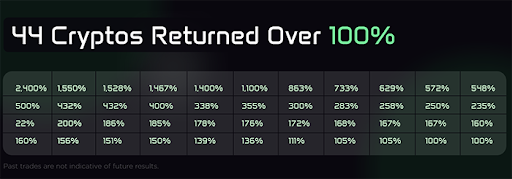Ticker Reports for August 30th
The Solar Stock Battle: Is Daqo or JinkoSolar Your Next Big Win?
The U.S. added a record-breaking 32.4 gigawatts of solar electric generating capacity in 2023, evidence of the continued growth of the renewable energy industry thanks to strong customer demand, supportive government policies, and rapid advances in solar technology. A long-term shift in the energy sector toward decarbonization through green energy sources is well underway and likely to continue for years to come.
In addition to the environmental advantages of solar energy, there is potential for investors to capitalize on a secular shift in the make-up of the energy sector more broadly. Selecting from the large pool of solar stocks is a difficult prospect, though, particularly as the market continues shifting and companies strive for dominance.
First Solar Inc. (NASDAQ: FSLR) is one of the largest companies in the solar space at just under $24 billion in market value. With over $1 billion in sales and a net income of almost $350 million in the most recent quarter, First Solar provides a benchmark for smaller, up-and-coming solar companies seeking to emerge as major players. Two such firms—Daqo New Energy Corp. (NYSE: DQ) and JinkoSolar Holding Co., Ltd. (NYSE: JKS)—reported earnings in the last week of August, allowing for a direct comparison. Unfortunately, both of the smaller companies face significant challenges, as revealed in their recent financials.
Daqo New Energy: Losses, Declining Sales and Prices
Chinese polysilicon component maker Daqo New Energy primarily sells its products to other solar manufacturers. As such, when the broader solar industry faces external challenges like oversupply, Daqo is particularly impacted. Market prices across the industry fell in the second quarter due in part to an inventory glut, in some cases to levels below production costs—as a result, Daqo's inventory market value fell below book value, and it recorded an inventory impairment expense of $108 million.
The impact of this unique expense on Daqo's broader financials for the quarter was significant. For example, the company reported net loss attributable to shareholders of just under $120 million as a result, worse than analysts expected, as well as gross losses of $159 million compared with gross profit of $72 million in the first quarter of the year.
Despite the impact of the impairment in the latest quarter, Daqo's bottom-line struggles are persistent. The company has failed to beat consensus earnings per share estimates each quarter for the last year. And despite an average polysilicon selling price of $5.12 per kilogram, down more than $2.50 from this time last year, Daqo's sales volume declined by more than 20% over that time period as well. These figures suggest deeper issues that have likely been exacerbated by industry-wide challenges in recent months.
JinkoSolar: Revenue Sluggish, Shipments Grow
Like Daqo, JinkoSolar posted net losses for the second quarter as a result of oversupply and low prices across the industry. The firm reported net loss of almost $14 million, or diluted loss per American depositary share (ADS) of $0.29. Revenue growth was up 4.4% sequentially but down almost 22% year-over-year.
In contrast to Daqo, however, JinkoSolar's shipments and demand continue to surge. The company reported year-over-year module shipments growth of more than 34%, with total quarterly shipments up 36% over the same period. This rapid improvement made it possible for JinkoSolar to become, during the second quarter, the first solar module maker to deliver a total of 260 GW solar modules. Newly added installations in China helped to drive this growth, but the company also experienced substantial growth of around 20% year-over-year in its total solar module exports.
All of this suggests that JinkoSolar's product lineup and positioning may help to it rebound along with the broader industry more quickly than a rival like Daqo.
How do Daqo and JinkoSolar Stack Up?
Based on recent reports, neither Daqo nor JinkoSolar has approached the success of First Solar. The largest of the three companies maintained profitability at a time when smaller competitors were stuck navigating excess inventory and historically low prices. In the short term, First Solar may be the stock for investors to watch most closely. However, the rapid growth in demand for JinkoSolar's products makes it a worthwhile company to keep an eye on, and Daqo's position could quickly change if there is a broad increase in prices industry-wide.
Exposed: 3 CENT Crypto to Explode September 23rd?
Chris Rowe – the man who recommended Amazon in 1998… Bitcoin and Ethereum in 2017…
And has spotted 44 different coins that have returned over 100%...
Today, he is now making the biggest crypto call of his ENTIRE career…
Are These Chinese Stocks a Buy? Michael Burry's Top Picks Say Yes
As several popular U.S.-listed Chinese stocks begin to show signs of a rebound, investors are left wondering whether now is the right time to jump back into the market or if these gains could be another value trap. The iShares China Large-Cap ETF (NYSE: FXI) has managed to buck its downtrend this year, trending nearly 10% higher year-to-date and consolidating above its 200-day SMA in a bullish pattern. However, with lingering concerns about the Chinese economy and regulatory environment, is it time to invest in these stocks, or should caution prevail? Let's take a closer look.
Can the Rebound in Chinese Stocks Sustain Itself?
Since the Lunar New Year, China's equity markets have shown signs of recovery, driven by better-than-expected GDP growth and positive development in the manufacturing and services sectors. Despite ongoing challenges such as a struggling property sector and geopolitical tensions, government measures like increased infrastructure investment and capital market reforms support the rebound.
China’s GDP grew 5.3% in Q1 2024, exceeding expectations and signaling a stronger-than-anticipated economic performance. This growth has contributed to the attractiveness of stock valuations, with the CSI300 and MSCI China indices trading below their historical averages. Looking ahead, earnings for 2024 and 2025 are expected to recover, particularly in sectors like industrials, utilities, and IT.
Analysts at Goldman noted that recent capital market reforms in China have also played a crucial role in this recovery. These reforms aim to balance market development and investor protection, focusing on improving IPO rules, enhancing disclosure, and supporting key areas such as technology and green investments. These measures are designed to foster a more robust and sustainable market environment.
While some obstacles remain, China's supportive policies and attractive valuations present a compelling opportunity for investors.
One investor who firmly believes in the rebound is Michael Burry, the investor made famous by the movie The Big Short. Let’s look at two U.S.-listed Chinese stocks that Burry holds in his portfolio, which might be a good option for investors seeking exposure to China.
Michael Burry’s Big Bet: Alibaba as His Top Portfolio Holding
Alibaba Group Holding Limited (NYSE: BABA) is a Chinese eCommerce and internet technology powerhouse. Its core platform, Alibaba.com, ranks as the world’s third-largest eCommerce platform by sales. The company boasts a market capitalization of $205 billion, a modest dividend yield of 1.21%, and a P/E ratio of 18.88.
Michael Burry has invested significantly in Alibaba, putting just over $11 million into the stock, making it the largest holding in his portfolio. This position, which he initiated in the first quarter, remains his top investment. After a mixed start to the year, Alibaba's shares have gained momentum, now up 5.4% year-to-date, and are solidly trading above key moving averages, including the 200-day SMA. The recent upward trend was bolstered by the company’s latest earnings report on August 15, where it exceeded EPS estimates by $0.20. For the full year, Alibaba is projecting earnings growth of 11.35% and is trading at an attractive forward P/E of 8.6.
Michael Burry Bets Big on Baidu Despite Recent Struggles
Baidu, Inc. (NASDAQ: BIDU) is a leading Chinese technology company specializing in internet-related services and artificial intelligence. Despite attractive valuation metrics, including a P/E ratio of 10.97 and a forward P/E of 7.24, which suggest the stock could be a potential value buy, BIDU has been caught in a steep and steady downtrend, with shares down nearly 30% year-to-date, proving to be a value trap.
Nonetheless, Michael Burry has increased his stake in Baidu by more than 30,000 shares, bringing his total position to 75,000 shares valued at nearly $6.5 million as of June 30. While the stock’s current trend and market sentiment appears bearish, analysts remain optimistic. Based on 16 ratings, Baidu holds a Moderate Buy rating with a consensus price target of $137.13, indicating a significant potential upside of 63%.
"Kamala Crash" to Begin on November 5th?
According to former advisor to the CIA, the Pentagon and the White House Jim Rickards…
Kamala and her puppet masters are planning this dirty election move…
Five Below Stock Faces Challenges Despite Strong Revenue Growth
Things were looking good for Five Below Inc. (NASDAQ: FIVE) the morning after earnings. FIVE stock moved up nearly 6% in after-hours trading as higher YoY revenue, and in-line earnings were a bright spot in an earnings season when winners among retail stocks have been few and far between. However, the positive vibes were short-lived after another discount retailer gave a sour report on the state of the consumer.
The headline numbers were a mixed bag. Revenue of $830.07 million was 10% higher YoY, but same-store sales fell 5.7%. Earnings per share (EPS) of 52 cents, while down 35.7% YoY, met analysts’ expectations. The company also lowered its guidance for full-year earnings. The new target range between $4.35 and $4.71 is down from $5.00 to $5.40.
Sector Weakness Sinks FIVE Stock
By now, investors may be getting tired of hearing about a bifurcated economy. However, it bears repeating. Your experience of the current economy is likely tied to your income level. Consumers above a particular income level are managing through higher inflation. But that’s not the case for low- to middle-income consumers.
That was supposed to work in favor of the discount retailers. However, Dollar General (NYSE: DG) delivered disappointing earnings the day after Five Below reported. What made the report particularly ominous was the dollar chain’s gloomy outlook for the consumer. In late afternoon trading, DG stock is down nearly 30%.
That makes the 4% drop in FIVE stock look a lot better. However, a loss is still a loss, and Dollar General’s sour outlook for the consumer only confirms what many investors, who are also consumers, feel. That is, low- to middle-income consumers who are the backbone of the discount retail sector are hurting.
Five Below’s Strategic Shift: Focusing on Existing Stores Over Expansion
Five Below acknowledged the consumer's weakened state. One strategy the company is taking to manage this time is to reduce the number of new stores it plans to open while emphasizing the strengthening of its existing stores.
In the quarter, the company opened 62 new stores. That was an 18% YoY increase in store count, and it increased the company’s footprint to 1,667 stores across 43 states.
Even with the plans to curb the expansion, the company is still forecasting a total of 1,774 stores by the end of the year, which will result in about 15% YoY growth.
Analyst Sentiment Points to More Losses for Five Below
The Five Below analyst forecasts on MarketBeat are mostly bearish. Five of the seven analysts that issued a price target for FIVE stock have a lower target. Even Craig Hallum, who upgraded the stock to Buy from Hold, lowered its price target to $102. That’s 6.9% lower than the consensus price of $109.63.
Five Below’s Digital Growth and BNPL Strategy: Keys to Future Success
FIVE stock is now trading near a five-year low set in 2020. At that time, the economy was all but shut down, and retailers like Five Below were the ones that were most affected. However, the company is launching off a significantly higher revenue base than it did at that time. The company has also enhanced its digital capabilities.
Lower interest rates may make the stock bullish. Five Below typically performs better in the second half of the year, which includes Halloween and the Holiday season. If the consumer starts to feel some relief, even if that’s more perception than reality, it could lead to better earnings in future quarters.
The company also embraces buy-now-pay-later (BNPL) financing with a program that allows consumers to make four installment payments over six weeks. Affirm Holdings Inc. (NASDAQ: AFRM) reported stronger-than-expected results that confirm that consumers may be using BNPL as a way to navigate higher prices.
That being said, in the short term, hope isn’t a strategy. The Relative Strength Indicator (RSI) indicates that FIVE stock may have further to fall before it can be considered oversold. Short interest is up more than 13% in the last month. As noted above, investor sentiment appears to confirm bearish sentiment.






0 Response to "🌟 Are These Chinese Stocks a Buy? Michael Burry’s Top Picks Say Yes"
Post a Comment